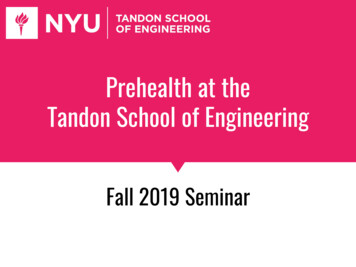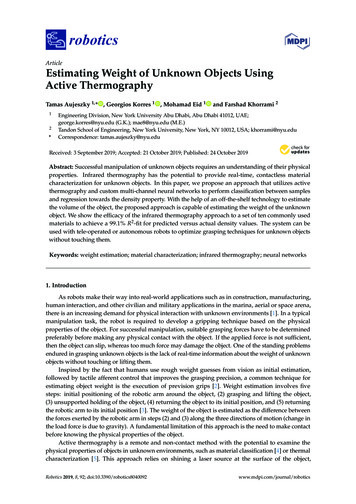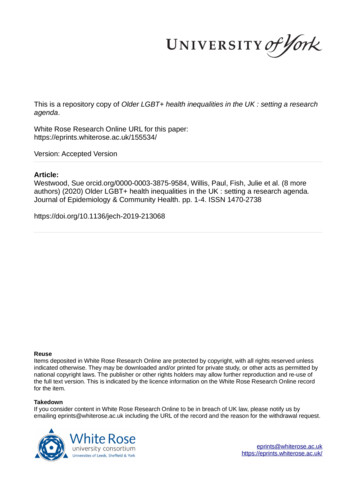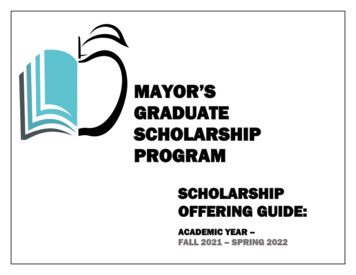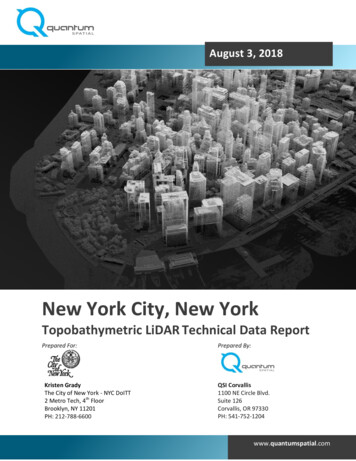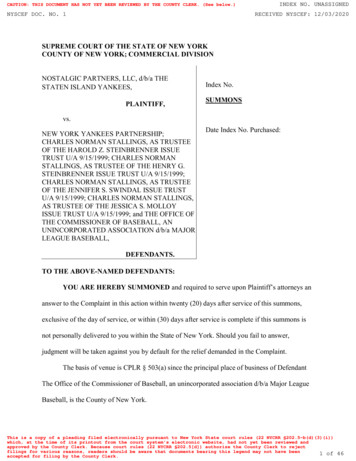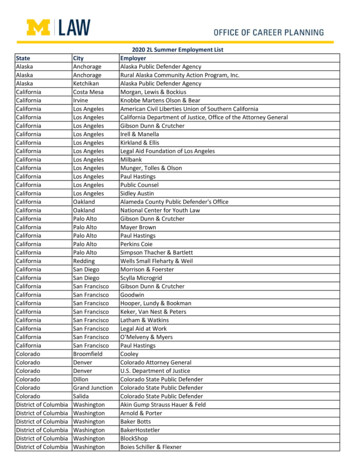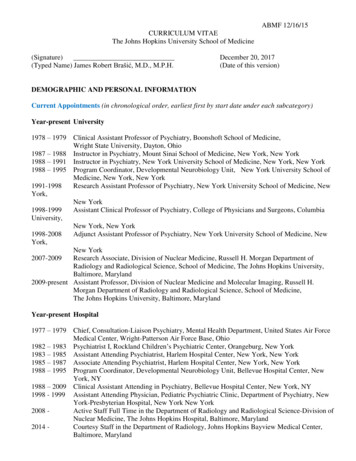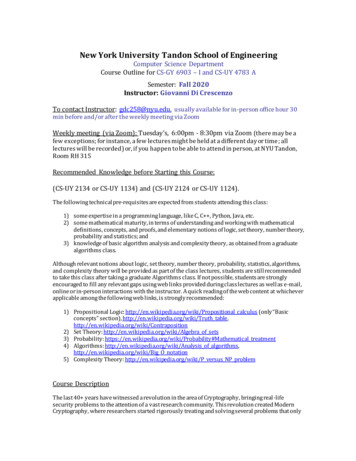
Transcription
New York University Tandon School of EngineeringComputer Science DepartmentCourse Outline for CS-GY 6903 – I and CS-UY 4783 ASemester: Fall 2020Instructor: Giovanni Di CrescenzoTo contact Instructor: gdc258@nyu.edu, usually available for in-person office hour 30min before and/or after the weekly meeting via ZoomWeekly meeting (via Zoom): Tuesday’s, 6:00pm - 8:30pm via Zoom (there may be afew exceptions; for instance, a few lectures might be held at a different day or time; alllectures will be recorded) or, if you happen to be able to attend in person, at NYU Tandon,Room RH 315Recommended Knowledge before Starting this Course:(CS-UY 2134 or CS-UY 1134) and (CS-UY 2124 or CS-UY 1124).The following technical pre-requisites are expected from students attending this class:1) some expertise in a programming language, like C, C , Python, Java, etc.2) some mathematical maturity, in terms of understanding and working with mathematicaldefinitions, concepts, and proofs, and elementary notions of logic, set theory, number theory,probability and statistics; and3) knowledge of basic algorithm analysis and complexity theory, as obtained from a graduatealgorithms class.Although relevant notions about logic, set theory, number theory, probability, statistics, algorithms,and complexity theory will be provided as part of the class lectures, students are still recommendedto take this class after taking a graduate Algorithms class. If not possible, students are stronglyencouraged to fill any relevant gaps using web links provided during class lectures as well as e-mail,online or in-person interactions with the instructor. A quick reading of the web content at whicheverapplicable among the following web links, is strongly recommended:1) Propositional Logic: http://en.wikipedia.org/wiki/Propositional calculus (only “Basicconcepts” section), http://en.wikipedia.org/wiki/Truth ) Set Theory: http://en.wikipedia.org/wiki/Algebra of sets3) Probability: ical treatment4) Algorithms: http://en.wikipedia.org/wiki/Analysis of algorithms,http://en.wikipedia.org/wiki/Big O notation5) Complexity Theory: http://en.wikipedia.org/wiki/P versus NP problemCourse DescriptionThe last 40 years have witnessed a revolution in the area of Cryptography, bringing real-lifesecurity problems to the attention of a vast research community. This revolution created ModernCryptography, where researchers started rigorously treating and solving several problems that only
a few years before were unknown or seemed impossible to solve or only had heuristic solutions.Today Modern Cryptography is a well-established mathematical discipline, with strong connectionsto several older disciplines such as Complexity Theory, Information Theory, Combinatorics, NumberTheory, and Coding Theory, and several applications to real-life problems. This AppliedCryptography class offers a comprehensive introduction to Modern Cryptography, and, specifically,its main problems, formalisms, solutions, and open questions, with a heavy focus on applicationaspects, including case studies for real-life uses of Modern Cryptography solutions.Course Objectives and OutcomesThe course will provide students with the opportunity to:1. Learn the main areas of Modern Cryptography, including their main problem statements andthe rigorous mathematical approaches used to formalize them2. Learn and describe how various cryptographic algorithms and protocols work, pointing outthe main techniques used in them, and proving/disproving most basic properties, such ascorrectness of decryption, digital signatures, authentication tags, and key agreement3. Evaluate functionality, security and performance properties of cryptography methods used ascomponents of complex security solutions4. Analyze the impact of errors or different designs of cryptography algorithms and protocols5. Describe the applications of cryptography algorithms and protocols to real-life problems andmany implementation issues in developing these solutions.At the end of the class the diligent student is also expected to be ready to initiate an advanced study oran applied research/development project on problems in the area, understand and use cryptographicsoftware tools, and select known cryptographic solutions (e.g., algorithms, protocols, key lengths, etc.)for a desired cryptography application.Course StructureThis course follows a “flipped-classroom” teaching model.Except for textbooks, the course’s technical material, including lecture slides and explanation videos,is posted online and available so that students can read or listen to it whenever and as many times itis desired or needed. This material is divided into 12 weeks, and contains, for each of the 12 weeks,1) a lecture document; i.e., a PDF file containing between 25 and 40 PowerPoint slides, withpointers to required or recommended textbooks, posted online by Monday of the appropriateweek (usually, many weeks in advance); and2) a lecture video; i.e., one or more video recordings of an explanation of the lecture slides,posted together with the lecture document.The course’s interaction with the instructor and (if any) TA(s) is structured as follows. Your weeklyonline meeting, instructor office hour and TA office hour are all reachable via NYU Classes. On anyweek, you can:1) attend a weekly meeting, usually on Tuesday 6pm EST (but see class schedule below), whichwill be a lecture summary review with focus on homework questions. This meetingassumes the students have already listened to the lecture videos. It consists of a summary ofthe lecture slides, and includes discussions and elaborations on some key topics, possiblyrequested by students via email during the week, and an opportunity for students to solvehomework questions. Attending these meetings is not mandatory but may improve your classgrade; part of your class grade depends on attendance and number of hw questions answered(graded for effort and not answer correctness), and extra credit will be given to students withthe highest number of correct answers;
2) attend an office hour with the instructor (usually, right before and/or after the weeklymeeting; say, Tuesday 5:30pm-6pm EST and/or 8:30pm-9pm EST); in these office hours theinstructor will address any questions on the lectures, homework, projects, extra credit,midterm and final; attending instructor office hours is not mandatory but students arestrongly encouraged to attend and actively participate by posing their questions;3) attend an office hour with the TA, if any (usually, on Wednesday and/or Thursday 8pm-9pmEST but check the class website for updated hours); in these office hours the TA will addressany questions on the lectures, homework, projects, extra credit, midterm and final; attendingTA office hours is not mandatory but students are strongly encouraged to attend and activelyparticipate by posing their questions.Exact days and times may vary, possibly based on students’ feedback.The instructor will send a weekly email to remind students of their expected duties for the week,including any updates to class duties and/or schedule. Students are strongly encouraged to followthe recommended schedule of class duties.The technical course material is divided into 12 lectures, whose content is detailed below.Lecture 1: History of cryptography, some background in probability and algorithms, classicalcryptography (shift cipher, monoalphabetic substitution cipher, polyalphabetic substitution cipher),encryption with perfect secrecy, one-time pad; implementation aspects: shared secret randomness vsperfect secrecyLecture 2: Some background in algorithms and complexity theory, modern cryptography principles,one-way functions, trapdoor functions, hard-core bits, construction of a public-key cryptosystembased on general cryptographic primitives, implementation aspects: computational efficiency vshardnessLecture 3: Algorithmic number theory, number theory and cryptographic assumptions, Reductions,proofs by reductions, number theory candidates for cryptographic primitives (e.g., factoring andrelated problems), public-key cryptosystems from number theory problems; brief discussion ofquantum computing; implementation aspects: large integer arithmetic for implemented public-keycryptosystemsLecture 4: Randomness and pseudo-randomness, pseudo-random generators, functions andpermutations. Symmetric encryption: introduction, security notions, symmetric encryption schemesbased on pseudo-randomness primitives, security proofs, fundamental concepts; implementationaspects: generating and testing randomnessLecture 5: Symmetric encryption: block ciphers (e.g., DES, Triple-DES, AES),substitution/permutation networks, Feistel networks, modes of operations (e.g., ECB, CBC, OFB,Counter), cryptanalysis attacks (e.g., exhaustive, linear, differential, meet-in-the-middle attack), keylengths; implementation aspects: security-performance-features tradeoffsLecture 6: Message authentication: introduction, notion and schemes (e.g., CBC-MAC), collisionresistant hashing (MD5, SHA-1, SHA-2, SHA-3, HMAC, Merkle-Hellman), CCA security for symmetricencryption, simultaneous message confidentiality and message integrity, the GCM mode, applicationcase study 1: password-based secure computer access; implementation aspects: securityperformance-features tradeoffsLecture 7: More number theory candidates for cryptographic primitives (e.g., discrete logarithms,brief discussion of related problems including elliptic curves). Asymmetric encryption: comparisonwith symmetric encryption, definitions, constructions (e.g., RSA variants, El Gamal), hybridencryption; implementation aspects: security-performance-features tradeoffs
Lecture 8: Asymmetric encryption: malleable and homomorphic encryption notion and schemes(e.g., Paillier, brief discussion of various schemes, including Gentry’s), additional schemes achievingvarious security notions in various models (e.g., Cramer-Shoup), identity-based encryption;implementation aspects: security-performance-features-trust tradeoffsLecture 9: Property-preserving public-key encryption, secure 2-party computation, secure multiparty computation; application case study 2: sugar beet auction; implementation aspects ofcryptographic protocols: transport layer, protocols over secure channelsLecture 10: Digital Signatures, hashing and signing, Hashed RSA, El Gamal and DSA signatureschemes, public-key infrastructures, certificates, cryptography in TLS, IPSec and virtual privatenetworks, NSA Suite B, application case study 3: secure online purchasing; implementation aspects:trust models, PKI implementation challengesLecture 11: Key protocols: key transport, key agreement, notions and schemes (e.g., Diffie-Hellmanschemes); key management: concepts and lifecycle; code obfuscation, application case study 4: digitalrights management; quantum computing, quantum-resistant cryptography; implementation aspects:creating correct and secure programs, quality of code, side-channel attacks, implementation flawsLecture 12: Key lengths and recommendations, user authentication: password, challenge-responseand zero-knowledge protocols; server authentication; application case study 5: secure onlinebanking; digital cash, application case study 6: keeping/storing secrets, blockchain, application casestudy 7: cryptocurrencies; implementation aspects: weakest key, key modularityReadingsThe required texts for the course are:1) [KL] J. Katz and Y. Lindell, Introduction to Modern Cryptography: Principles and Protocol s,Chapman & Hall/CRC Press, 2nd edition (see http://www.cs.umd.edu/ jkatz/imc.html)2) [MOV] A. Menezes, P. Van Oorschot, S. Vanstone, Handbook of Applied Cryptography, CRCPress, August 2001, fully available online at http://www.cacr.math.uwaterloo.ca/hac/)Note: text (1) contains about 85% of the class material; text (2) contains about 50% of the classmaterial; past cs6903 students typically found it easier to study on lecture slides and to use (1) tostrengthen understanding.Optional and recommended texts are:1) One among the following two texts:a. [FSK] N. Ferguson, B. Schneier and T. Kohno, Cryptography Engineering: Design,Principles and Practical Applications, Wiley Publishing, Inc., 2010 (this book givesexposure to more cryptography engineering aspects and might be considered amodern follow-up of (1b), the first book that was written on the topic)b. B. Schneier, Applied Cryptography, 2nd edition, J. Wiley and Sons.2) W. Stallings, Cryptography and Network Security: Principles and Practice, 2nd edition,Prentice Hall.3) Books at f52.htmlCourse requirements
Homework assignments are multiple-choice tests where you are presented a set of questions andare required to choose the correct answer among 4 possible ones. You will also be asked to provide abrief rationale for your answer to these questions. For i 1, ,4, homework hw[i] typically refers tolectures 3i-2, 3i-1, 3i and is due by the end of the week dedicated to Lecture 3i. During the weeklyonline meeting, the instructor will go over hw problem explanations, the students will have a chanceto answer the questions, and the instructor will go over hw solutions (or, if there is no time, possiblymade the answer available in a recorded video). Homeworks should be considered (the only)practice problems for your midterm and final exams. Homework is graded for effort (i.e., how manyquestions are answered with a rationale that shows that the student tried to answer the question)and not for correctness of answers. Of course, for more successful practice for midterm and final, thestudent should answer hw questions as if they were midterm or final questions.The projects consist of solving practical problems (via software implementation) including: (1) thebreaking or design of (variations of) a number of known cryptographic primitives (e.g., encryptionschemes, authentication schemes, etc.); and (2) designing and implementing privacy and securitysolutions, based on the cryptography studied in class, as an improvement to a real-life system. Inaddition to implementation tasks, the projects will require a presentation document possiblyincluding details on software documentation, cryptography design, cryptanalysis, performanceanalysis, etc. A project will have to be realized by a team of a number of students (to be decidedduring the class), and comes with a minimal assignment. Any additional work performed by thestudent(s) will be considered extra credit work. We will have a workshop day where each studentwill have a chance to present at least one of the projects. Students with the best projects will receiveextra credit. Authorized sources: personal notes, required or recommended textbooks, and other websources (only if they are properly quoted and not plagiarized). No collaboration is authorized withstudents beyond your team, or with parties external to the course. The following collaboration withinstructor and TAs is authorized: you can ask via e-mail or during office hours for clarifications onthe project problem statement (or about any solutions, after grades have already been posted).The midterm is based on lectures 1-6; you will be given a number of questions in some “enhancedmultiple-choice format”, for which the answers may require writing a brief rationale, as forhomework questions, and you will be given a time limit (i.e., 3 hours) to write your answers. Themidterm is a proctored test where you are allowed to inspect your textbook and lecture slides. Formore detailed info on authorized (or not) sources, see info posted by the instructor. If the instructoris proctoring your exam, you can ask the instructor for clarifications on question statements. Nocollaboration is authorized with anyone else.The final is based on lectures 7-12; you will be given between a number of in some “enhancedmultiple-choice format”, for which the answers may require writing a brief rationale, as forhomework questions, and you will be given a time limit (i.e., 3 hours) to write your answers. The finalis a proctored test where you are allowed to inspect your textbook and lecture slides. For moredetailed info on authorized (or not) sources, see info posted by the instructor. If the instructor i sproctoring your exam, you can ask the instructor for clarifications on question statements. Nocollaboration is authorized with anyone else.The following opportunities for extra credit (for which collaboration among students is allowed)will be offered:1)2)3)4)5)6)seminar attendance,useful feedback provided to the instructor at the end of the semester,highest numbers of correct answers on a weekly meeting,best projects,additional work on projects, andadvanced topic surveys.
You can take opportunities 1,2,3,4 and no more than one among 5,6.All your work (homework, projects, midterm, final, extra credit) should be submitted on NYU Classes,under Tests and Quizzes, or will likely be not evaluated for class grade purposes.Generally, students are very much encouraged to e-mail their technical and non-technicalquestions (including class organization, etc.) to the instructor; questions can be sent at any time,and an answer would likely appear within 1 or 2 business days. For real-time answers, office hoursare more appropriate. We will also have an online forum which can be more appropriate forquestions among fellow students, live updates to course material or real-time communication fromthe instructor, etc. The instructor is also happy to make time for a limited number of one-on-oneoffice hours outside of the designated times. The diligent student is expected to generate a weekly listof unclear technical issues to clarify with the instructor and/or the TA through the above channels.The student’s course grade will be tentatively determined as a weighted average, as follows: classparticipation through attendance and hw answer attempts (5%), homework completion (10%),project1 (15%), project2 (20%), midterm (25%), final (25%). Weights are tentative and mightslightly change (for instance, slightly increasing the weight of the final is possible). Incomplete gradeswill not be given, unless under exceptional circumstances. Homework submitted later than the duedate is eligible for partial credit that decreases with time. Submitting homework late will always bemore convenient than submitting no homework but never more convenient than submittinghomework before the due date. The instructor will not drop students’ lowest homework score.The course’ schedule and due student activities are summarized below:Week123456789101112131415Class EventsLecture 1 (Tu, Sep 8)Lecture 2 (Tu, Sep 15)Lecture 3 (Tu, Sep 22)Lecture 4 (Tu, Sep 29)Lecture 5 (Tu, Oct 6)Lecture 6 (Tu, Oct 13)Midterm exam (Tu, Oct 20)Lecture 7 (Tu, Oct 27)Lecture 8 (Tu, Nov 3)Lecture 9 (Tu, Nov 10)Lecture 10 (Tu, Nov 17)Lecture 11 (Tu, Nov 24)Lecture 12 (Tu, Dec 1)Workshop (project presentations) and finalreview (Tu, Dec 8)Final exam (Tu, Dec 15)What’s due?HW1 on Lectures 1-3 (Sat, Sep 26)HW2 on Lectures 4-6 (Thu, Oct 15)Project 1 (Sun, Oct 25)HW3 on Lectures 7-9 (Sat, Nov 14)HW4 on Lectures 10-12 (Thu, Dec 3)Project 2 (Mon, Dec 7)Extra credit (Sun, Dec 20)Moses Center Statement of DisabilityIf you are student with a disability who is requesting accommodations, please contact New YorkUniversity’s Moses Center for Students with Disabilities (CSD) at 212-998-4980 ormosescsd@nyu.edu. You must be registered with CSD to receive accommodations. Informationabout the Moses Center can be found at www.nyu.edu/csd. The Moses Center is located at 726Broadway on the 3rd floor.NYU School of Engineering Policies and Procedures on Academ ic Misconduct – com pleteStudent Code of Conduct hereA. Introduction: The School of Engineering encourages academic excellence in anenvironment that promotes honesty, integrity, and fairness, and students at theSchool of Engineering are expected to exhibit those qualities in their academic work.
It is through the process of submitting their own work and receiving honest feedbackon that work that students may progress academically. Any act of academicdishonesty is seen as an attack upon the School and will not be tolerated.Furthermore, those who breach the School’s rules on academic integrity will besanctioned under this Policy. Students are responsible for familiarizing themselveswith the School’s Policy on Academic Misconduct.B. Definition: Academic dishonesty may include misrepresentation, deception,dishonesty, or any act of falsification committed by a student to influence a grade orother academic evaluation. Academic dishonesty also includes intentionallydamaging the academic work of others or assisting other students in acts ofdishonesty. Common examples of academically dishonest behavior include, but arenot limited to, the following:1. Cheating: intentionally using or attempting to use unauthorized notes, books,electronic media, or electronic communications in an exam; talking withfellow students or looking at another person’s work during an exam;submitting work prepared in advance for an in-class examination; havingsomeone take an exam for you or taking an exam for someone else; violatingother rules governing the administration of examinations.2. Fabrication: including but not limited to, falsifying experimental data and/orcitations.3. Plagiarism: intentionally or knowingly representing the words or ideas ofanother as one’s own in any academic exercise; failure to attribute directquotations, paraphrases, or borrowed facts or information.4. Unauthorized collaboration: working together on work meant to be doneindividually.5. Duplicating work: presenting for grading the same work for more than oneproject or in more than one class, unless express and prior permission hasbeen received from the course instructor(s) or research adviser involved.6. Forgery: altering any academic document, including, but not limited to,academic records, admissions materials, or medical excuses.NYU School of Engineering Policies and Procedures on Excused Absences – com plete policy hereA. Introduction: An absence can be excused if you have missed no more than 10 daysof school. If an illness or special circumstance has caused you to miss more thantwo weeks of school, please refer to the section labeled Medical Leave of Absence.B. Students may request special accommodations for an absence to be excused in thefollowing cases:1.2.3.4.Medical reasonsDeath in immediate familyPersonal qualified emergencies (documentation must be provided)Religious Expression or PracticeDeanna Rayment, deanna.rayment@nyu.edu, is the Coordinator of Student Advocacy,Compliance and Student Affairs and handles excused absences. She is located in 5 MTC,LC240C and can assist you should it become necessary.NYU School of Engineering Academic Calendar – complete list here.
The last day of the final exam period is . Final exam dates for undergraduate courses willnot be determined until later in the semester. Final exams for graduate courses will be held on thelast day of class during the week of . If you have two final exams at the same time, reportthe conflict to your professors as soon as possible. Do not make any travel plans until the examschedule is finalized.Also, please pay attention to notable dates such as Add/Drop, Withdrawal, etc. For confirmationof dates or further information, please contact Susana: sgarcia@nyu.edu
Lecture 3: Algorithmic number theory, number theory and cryptographic assumptions, Reductions, proofs by reductions, number theory candidates for cryptographic primitives (e.g., factoring and related problems), public-key cryptosystems from number theory problems; brief discussion of

